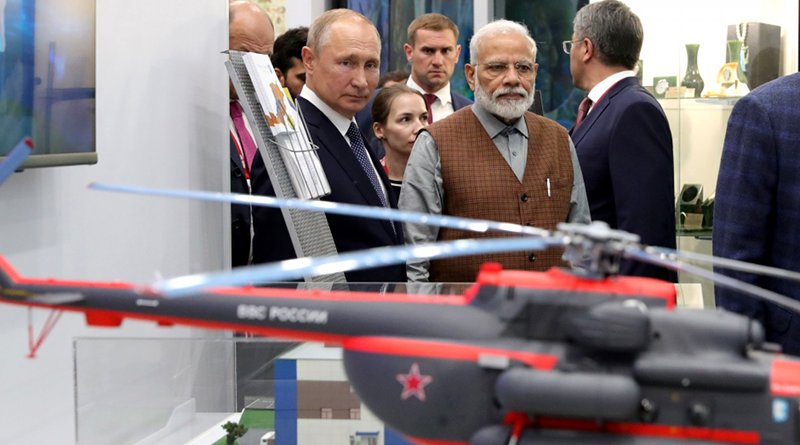Maritime Connectivity To The Russian Far East Necessitates Naval And Arctic Planning – Analysis
By IPCS
By Dr. Vijay Sakhuja*
In September 2019, India’s Prime Minister, Narendra Modi, traveled to Russia where he was the chief guest at the 5th Eastern Economic Forum. During this visit, India and Russia signed multiple agreements on a range of topics. Specifically, New Delhi and Moscow signed a Memorandum of Intent to establish ‘maritime communication’ between Chennai and Vladivostok. The primary purpose of opening the route to the Russian Far East is to increase the volume of existing bilateral trade, which is expected to touch US$ 30 million in value by 2025. The cargo and commodities to be traded via this route have been identified as energy resources and agro based products such as timber, and would be transported from Vladivostok bound for Chennai.
Plans for maritime connectivity between the Russian Far East and India can be traced back to 2006 when the Russian tanker, MK Viktortitov, transported the first consignment of oil from Sakhalin-I to the New Mangalore Port, to be processed at the refinery. India’s then Minister of Petroleum and Natural Gas, late Murli Deora, labeled the 5,700 nautical miles long Sakhalin-Mangalore route as the “new silk route” and “new route of integration,” and called Russia an important friend whom India looks upon for its “energy needs and security of the country.” A similar euphoria is now visible and can be gleaned from the commentaries and op-eds that are doing rounds in the media, as also among the strategic community and think-tanks.
At this juncture, it is useful to understand at least three important aspects that anchorinternational shipping. First, that it is driven by profits, and freight forwarders and shipping companies make clear choices based on whether or not the voyage will be lucrative. The second pertains to the availability of ships to ensure that large volumes can be transported in a sustained manner. The third is the location of the port from where cargo is collected and finally discharged.
The Port of Vladivostok is the only multipurpose port in the Russian Far East and handles a variety of cargo including, bulk, containers, oil products, cars, heavy-duty vehicles etc. Over the past few years, its cargo handling has improved consistently. It is to be borne in mind that the Port of Vladivostok is located at higher latitudein the Arctic Circle and experiences severe sea-ice conditions between the months of December and March. This factor limits operations to those by ice-class vessels of category Ice2. However, assistance for icebreaking vessels can be obtained from port authorities by ships at the owner’s requests and expense. Currently, none of the Indian flagged vessels are ice-capable, which would require either Russian flagged vessels or chartering tankers from the market, but this is not a major challenge. However, in the instant case, there is little information about the amount of oil or gas that India wishes to import through Vladivostok to help determine the final landing cost.
Be that as it may, the latest development merits attention of Indian naval planners who must now think about the ‘new sea lane’ through the prism of security. Originating in Russia’s Far East and passing through the South China Sea and the Malacca Strait to Indian ports, the route entails careful safety as well as geopolitical and geostrategic risk assessments. The cargo must be secured against usual risks such as natural catastrophes (hurricanes and storms) and asymmetric threats and challenges that plague the South China Sea. Furthermore, the safety of such cargo is compounded by possible interception by China’s People’s Liberation Army Navy. It is fair to assume that Russia and China are strategic partners and this relationship should dissuade China from intercepting any Russian vessel/cargo bound for India. Also, a quid pro quo situation may arise, prompting the Indian Navy to pursue a corresponding response. In this regard, it would be useful to recall a recent contestation between Iran and UK after the former intercepted an Iranian vessel in the Mediterranean Sea.
The Indian Navy already has a well-practiced energy sea-lane security strategy for the route between the Persian Gulf and Indian ports. Furthermore, its capacity and capability to escort/protect critical energy shipments during prolonged crisis/wars is well known. For instance, in June 2019, under the aegis of Operation Sankalp, the Indian Navy deployed warships to ‘reassure’ Indian flagged vessels operating/ transiting through the Persian Gulf and the Gulf of Oman following heightened tensions between the US and Iran and the latter had commandeered a British flagged vessel.
It is worth pointing out that the Indian Navy is committed to several other naval operations in the Indian Ocean and these engagements may curtail deployment in the South China Sea. Under the circumstances, a possible approach to protect Indian flagged/cargo carrying shipping through the South China Sea could be a cooperative mechanism among the maritime and naval forces of Japan and the US with whom India already has a working arrangement.
Finally, it would be useful for India to also
think about Vladivostok as a springboard for its future engagement in Russia’s global energy market and the Arctic
region involving the new Arctic LNG 2 project, the
future project Arctic LNG 3, and the Northern Sea Route, which would be open
for navigation for longer periods in the times to come.
Dr Vijay Sakhujais a former director of the National Maritime Foundation, New Delhi.

